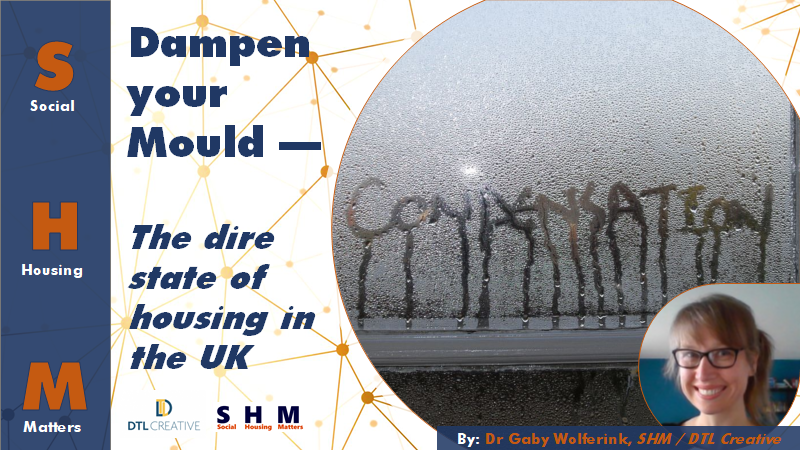
After an initial widely shared and discussed ITV report from 22nd March 2021, it took another report on the 13th of April for the Housing Ombudsman to launch an investigation into some dire living conditions for many (social housing) tenants across the country.
In a response to the initial report, Housing Secretary Robert Jenrick said that while he was “disgusted by the images revealed by ITV” and “those practises will be rooted out”, he “does not think the conditions of the social housing in Croydon are representative of the whole of the UK”.
However, in response to both the first and second report, reporter Daniel Hewitt “was ‘inundated’ with ‘hundreds and hundreds’ of examples”. “ITV News investigations have found there is a ‘growing problem with severe mould and damp’ throughout the UK, with councils often not dealing with residents’ complaints.”
The Blame Game never changes…

The blame for mould and damp, as Hewitt explains in an interview, is often placed with the tenants themselves. This is something that I recognise myself. I have heard it working in the social housing sector for over 10 years in two different countries. I’ve heard it from many peers working in both sectors, especially in the UK. I’ve heard and experienced it living in a 1960s-built terraced home.
As Hewitt says, tenants are told that “they are not ventilating their flat enough, they are not opening the window, they are using the washing machine too much. Effectively the mould and damp is their own problem.”
I have heard many housing staff utter these same phrases in response to reports of damp straight away. Even before someone has had a look that. I’ve seen numerous of such complaints, and which were mostly pleas for help.
I’ve been told it myself by a former private sector landlord, living in a home with radiators placed on internal walls rather than external walls, ventilating the property daily even throughout winter, not even owning a washing machine and only drying washing inside if the weather was absolutely dire outside.
Of course, upon terminating the tenancy, my deposit was withheld because they found specs of mould upon inspection. Specs of mould, after cleaning entire swathes of it throughout our tenancy, from the very beginning; we were at fault.
Damp, mould and condensation are flogged as a ‘lifestyle problem’. This approach ignores the age and/or low build quality of many homes still present in social housing stock. The lack of enough decent homes fit for the 21st century is not a secret. As Hewitt said, “there are almost half a million people in England living in sub-standard social housing in this country. 200,000 of them are living in properties with damp, with risk of electrocution”. This is not a big state secret either. These numbers come from government data.
Proof is in the… putting in sensors
I’m writing to tell you, if you didn’t know already, that there is technology available that can help with detecting and preventing mould and damp from spreading to the levels as seen in the recent reports.
Specifically, the most useful technology here is sensor technology, which falls in the realm of ‘Internet of Things’ technology. We can place sensors in homes that send data with information on humidity, temperature, airflow, movement and many more things using Wi-Fi. The sensor sends the data to an online platform that can track, analyse and send out reports and warnings to whomever has access to that platform.
There are many providers of sensor technology, and there are quite a few landlords investing in the technology and/or running and starting pilots already, although many still use the excuse of ‘cost’ to not start trying things out, even though it can help save both them and the tenants living in the homes they manage a lot of money in the long run.
Danger, Will Robinson

As with everything, there is a danger that technology can be used for, well, less great things, even if the motivations of their creators were benign to begin with.
Going back to one of my first housing tech events, I remember the anecdote of one of the attendees about a landlord who welcomed the opportunity for housing providers to turn off boilers and other essential appliances remotely to force rent payments or evictions. This is a bad take on the great possibilities that remote control of such appliances have for health and safety concerns. Sensor technology, the data and information also have the power to be used in a similar way.
Instead of driven by a desire (and duty) to ensure safe and healthy homes for all, I can see the tool being implemented mainly as a tool to further the narrative of blame and mould and damp as lifestyle problems in homes that everyone knows are prone to damp and mould.
As emphasised in this Public Sector Build Journal article, which outlines the impact of the Homes (Fitness for Human Habitation) Act,
“With responsibility for thousands of properties, the new legislation creates specific challenges for social landlords. These will include ensuring that their homes meet the specified standards, quickly identifying those that aren’t – and importantly understanding why and who was responsible for any persistent failings.”
Excuse me? Challenge? Like with multiple reports from ITV being needed to at least plant some seedlings of urgency to dealing with this widespread problem of mould and damp, clearly it takes a new Act for social landlords to get their ducks in a row and suddenly ‘face a challenge’ to ensuring homes meet certain standards… and of course there is the ‘who was responsible’ phrase that can get us into a big grey area if we don’t acknowledge the limitations of sensor data and place it over lived experience and wide-spread socio-economic factors that play a role in the current state of the UK’s housing stock.
There’s more than meets the eye-opening data from sensors
Don’t get me wrong. I absolutely LOVE the possibilities that come with sensor technology. I do believe that it can help all parties involved to create healthier living environments. Sensor technology can help us learn more about (our own) habits. It can show us where we can make potential savings when it comes to heating our homes. Combined with other SMART technology, such as remotely operated thermostats, it has the potential to not only make our lives easier, but also to rethink and redesign the way we live.
There are few big and very important things that should accompany the spread of sensor technology across the world, and with that the social housing sector in the UK. We have to appreciate and embrace these technologies without losing sight of what happens in the real world to the very real people (not reference numbers or complaints cases) living in their homes.
Just stop it

Successful and ethical use of technology in order to address and monitor living conditions, always has to start with, the following. And let me put this very, very bluntly:
STOP BLAMING TENANTS FOR DAMP AND MOULD AS A STANDARD ANSWER TO AVOID DOING THE WORK TO ADDRESS THE ROOT CAUSES.
STOP IT. Just stop it.
Period.
The lack of enough decent homes fit for the 21st century, or even the end of the 20th, is not a secret, as Hewitt said on the 22nd of March 2021:
“there are almost half a million people in England, and we know this from government data, living in sub-standard social housing in this country, 200,000 of them living in properties with damp, with risk of electrocution.”
Secondly, from the examples of Ms Franksoy Hewitt and Mr Leroy McNally, the two tenants who featured in the initial ITV report, it is clear that they too have received that standard response for ages without anyone taking them seriously, placing both blame and the onus to resolve it with the tenant.
Croydon Council ignored the complaints for over 5 months, but they were soon to send out inspectors, express apologies and organise alternative accommodation – within 24 hours – after ITV sharing their report and asking for comment. It shouldn’t take a journalist raising awareness for this to get any attention.
This is the social housing sector. Of course, all landlords, but especially social landlords, including councils, are responsible to provide safe and healthy homes to their tenants as a matter of principle, it should be at the very core of their being. With this very basic mission statement should come the knowledge and acknowledgement of the state of the UK’s social housing stock.
See the Big Data picture

And that’s where my second big point comes in. We need to not only use the sensor data from as many (social) homes as we can. We also need to combine them with the lived experiences of the people living in these homes. Only then can we make a holistic case for building not only more, but also better homes.
Yes, a single sensor in a single home can help a single tenant to save on energy bills.
Yes, a single temperature sensor can alert a landlord to any signs of financial struggles. Especially when combined with data from rent accounts and from incoming calls (or lack thereof). It can help them reach out sooner in an appropriate way.
Yes, multiple sensors in the same block can help prove that complaints aren’t just from one tenant. Data from more than one sensor telling the same story can help you rethink a landlord’s timescales for planned maintenance. This can help prevent the spread of damp and mould, keeping tenants safe and their living environments healthy.
Hell yes, we should invest in all of this.
These are good things for individuals at one point in time, but they are reactive and small-picture. These instances are a plaster on a wound that is far too big and infected to be sorted with a simple one-size-fits-one band-aid. They are quick fixes that only touch the surface of what we should be doing with these kinds of data.
I’m not saying that we should stop investing in these quick wins. Nor am I saying that we shouldn’t help individuals tenants, and improving individual homes. However, we need these technologies to help us create a better future for housing. We cannot let these individual wins stay what they are. They need to be the catalysts for more. They need to show the bigger picture; the big data picture of the dire state of housing.
Build for more, not for less
This means we will need to find ways to bring all the information, all the things we learn about our living environments, together. Not just within one street or block of homes, not just within one organisation. Not even just within one city, not just within one county or even country. In fact, we need to work globally to build better homes. But, as we’re talking social housing here, let’s start with housing associations working together.
When we work together, technology can help us all become more aware of how we are living. It can also show us how we might change some things that help create a more sustainable future. We are already doing that in some ways, but it is sad to see that most of the innovation happens in homes built to sell. A future with safe and warm homes should not just be for those who can afford it, but for everyone.

The entire sector, and all those working in and of the fringes of it, need to set aside any desires they might have for financial gain and/or competitive natures to be ‘the first, the one and only’. Instead, they have to work together from the get-go to design and build homes that work. They must bring together everything they know to convince government and other funding bodies available, that they need more financial support to build homes fit for the 21st century. They must also come together to fight the ‘race to the bottom’ way of selecting and acquiring resources and building sub-standard quality homes, and scrutinise the builders we select for building our social homes.
Together we can prove that damp and mould are not a lifestyle problem, but more often than not the result poor building quality and, in a way, of wide-spread tenant stigma. Why? Because the stigma informs resource allocation, design choices and the way we react to the first signs of trouble. ‘It’s good enough for social housing’ is something we don’t need to hear more of. If we don’t, and if we don’t use technology to help tackle every challenge that tenants face that are out of their own control, why bother with technology in social housing at all, or social housing for that matter?



